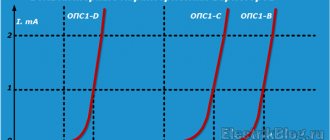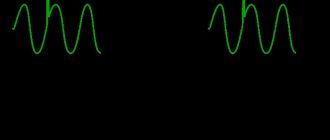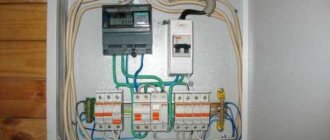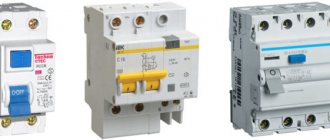Pulse overvoltage is a short-term sharp increase in voltage in the electrical network. Despite the fact that this surge does not last long (a fraction of a second), it is extremely dangerous both for the line and for the energy consumers connected to it. To prevent damage to cables and electrical devices, surge protection devices are used. In this material we will talk about what these devices are, what types they come in, and also consider how SPDs for a private home are connected.
Causes of surge voltage
IP can occur due to both technological and natural reasons. In the first case, a sharp drop in potential difference occurs when a switching overload occurs at the transformer substation from which the power supply for a particular line comes. Pulse overvoltage caused by natural causes occurs when, during a thunderstorm, a powerful discharge strikes the lightning protection of a structure or an electrical transmission line. Regardless of what causes a power surge, it can be very dangerous for your home electrical system, so to effectively protect against it, you need to connect a surge protector.
Lightning protection of electrical networks
A direct lightning strike into a house is fraught not only with the threat of causing direct damage to the structure, but also leads to the formation of strong electromagnetic fields and induced currents. These physical effects cause significant voltage surges that can damage any equipment that is connected to a household electrical outlet during a thunderstorm.
Routers, network switches (switches) and computers are especially often affected by thunderstorms. When electrical discharges are directly exposed to electrical wiring, the wires may melt and a short circuit may occur, often leading to a fire.
In order to prevent the possible consequences of a thunderstorm, it is customary to use special technical means. They limit voltage and reduce the effect of electromagnetic interference. Such lightning protection means include:
- special arresters;
- voltage stabilizers;
- surge suppressors OVR and other similar devices.
Please note that the functions of a pulse arrester and a limiter are combined in a number of modern electrical appliances, so their division into separate types is purely arbitrary.
Why do you need to connect an SPD?
In order to protect the electrical network and the devices connected to it from powerful current pulses and sudden voltage changes, a device is installed to protect the line and equipment from pulse voltages (abbreviated as SPD). It includes one or more nonlinear elements. The connection of the internal components of the protective device can be made either in a certain combination or in various ways (phase-phase, phase-earth, phase-zero, zero-earth). In accordance with the requirements of the PUE, the installation of an SPD to protect the network of a private house or other separate building is carried out only after the introductory circuit breaker.
Visually about the SPD in the video:
Basic Safety Rules
There are several basic rules that will help protect yourself from this natural electrical discharge:
- Remove all metal products from yourself and place them at a distance of 6 meters. The umbrella you use can also be a lightning bait.
- Move calmly, without fussing, especially in open areas.
- Don't forget to turn off your mobile phone. There have been cases where an incoming call was attracted by lightning.
- If the shelter is far away, duck down and stay alone. Try to find some kind of depression in the ground. Sit on the ground or squat with your legs together and your arms wrapped around them (fetal position). You can't lie down on the ground! Try not to be the highest point.
- Do not touch metal structures - fences, etc. and do not approach them.
- Do not ride a horse, bicycle, moped or open-top vehicle.
- If you are driving a car, slow down or stop. Stay away from tall trees or high-voltage lines. Stay in the car without touching or leaning against metal parts.
- If you are swimming, get out of the water and get into shelter.
Figure 2. It is better to wait out the thunderstorm in shelter.
If you are sailing on a boat, moor to the shore or find a tall building such as a bridge and stay under it (Figure 2).
Types of SPDs
These devices may have one or two inputs. Both single-input and double-input devices are always connected in parallel to the circuit they protect. In accordance with the type of nonlinear element, SPDs are divided into:
- Commuting.
- Limiting (mains voltage limiter).
- Combined.
Switching protective devices
Switching devices in normal operating mode are characterized by high resistance. When there is a sharp increase in voltage in the electrical network, the resistance of the device instantly drops to a minimum value. The basis of network protection switching devices are arresters.
Network surge suppressors (OSV)
The surge suppressor is also characterized by a high resistance, gradually decreasing as the voltage increases and the electric current increases. A gradual reduction in resistance is a hallmark of limiting SPDs. The mains overvoltage limiter (OSL) has a varistor in its design (this is the name of a resistor whose resistance value is nonlinearly dependent on the voltage acting on it). When the voltage parameter becomes greater than the threshold value, there is a sharp increase in the current passing through the varistor. After smoothing out the electrical impulse caused by a switching overload or lightning strike, the mains voltage limiter (SVR) returns to its normal state.
Combined SPDs
Combined type devices combine the capabilities of switching and limiting devices. They can both commute the potential difference and limit its increase. If necessary, combined appliances can perform both of these tasks simultaneously.
Signs of impending storm
It is quite possible to foresee the approach of this dangerous phenomenon and take refuge in a safe place in advance, avoiding sad consequences. The main thing is to monitor the development of cloudiness in the sky, in particular, the appearance of powerful cumulus and tower-shaped clouds.
It is difficult to determine a thunderstorm by the direction of the wind, since it often goes against the wind. In addition, the direction can change quickly: there can be a sharp squall wind, then complete calm and it becomes quiet and quiet, and then it starts to rain. But rain does not always happen - this phenomenon is called a dry thunderstorm (Figure 3).
Also, the approach of a thunderstorm can be determined by the high level of air humidity. It seems to become so thick that it is difficult to breathe.
You can also identify a thunderstorm by watching birds and insects. Birds fly low and low, and insects become especially aggressive, for example, flies begin to bite strongly. There is also a decrease in atmospheric pressure.
Figure 3. If you pay attention, you can know in advance that a thunderstorm is approaching.
You can very easily learn to calculate the distance of a thunderstorm front by the delay time of the first clap of thunder and the first flash of lightning. Since the speed of light is enormous, we see flashes of lightning before we hear peals of thunder. The speed of sound in air is 340 m/s. Many people know that in three seconds sound travels a distance of 1 km (this is not difficult to calculate).
If the time from the first flash of lightning to the clap of thunder decreases, it means the storm clouds are approaching, and if it increases, it means the thunderstorm is leaving. The most dangerous thing is when, after lightning appears, it immediately turns dark - this means that a thunderstorm is right above you.
Classes of IP protection devices
There are 3 classes of line surge protection devices:
Class I devices are installed in a distribution board or incoming cabinet and allow you to protect the network from surge voltage when an electric discharge hits a power line or lightning protection during a thunderstorm.
Class II devices provide additional protection for the electrical line from damage caused by lightning strikes. They are also installed when it is necessary to protect the network from surges caused by switching. They are installed after class I devices.
Video about SPD from ABB specialists:
Class I+II devices provide protection for individual residential buildings. These devices are installed near electrical equipment. They play the role of the last barrier, smoothing out the residual overvoltage, which, as a rule, is of insignificant magnitude. Devices of this class are produced in the form of specialized electrical sockets or plugs.
The simultaneous installation of class I, II and III devices guarantees three-stage protection of the electrical line from surge voltage surges.
System health check
To check the system for operating efficiency, the grounding loop is tested, which makes it possible to determine the level of transient resistance of lightning rods. All installed lightning protection systems are subject to inspection.
There are regulatory documents that set deadlines in compliance with which inspections are carried out. The frequency of inspections is regulated: for the first and second categories - annually, for the third category - once every three years. However, the third category also requires an annual check of bolted connections for transient resistance. Grounding loops undergo external inspection every six months. On an annual basis, partial excavation of the soil is carried out to inspect the system.
The essence of the testing process is to conduct an external inspection and measure the resistance indicator. External inspection concerns contacts between down conductors and receivers. The welded joints are tapped with a hammer to check their strength.
According to the standards, a significant excess of the resistance indicator is allowed, but not more than five times the acceptance testing data. Measurements are made using specialized equipment certified for such work.
How to connect an SPD in a private house?
Protective devices can be connected to household electrical networks (with one phase and operating voltage 220V) and to current-carrying lines of industrial facilities (three phases, 380V). Based on this, the complete SPD connection diagram provides for the effect of the corresponding voltage indicator.
If the role of grounding and neutral conductor is played by a common cable, then in such a circuit a simple single-block SPD is installed. It is connected as follows: a phase conductor connected to the input of the protective device - an output cable connected to a common protective conductor - the protected electrical appliances and equipment.
In accordance with the requirements of modern electrical documentation, the neutral and grounding conductors should not be combined. Based on this, in new homes, to protect the circuit from voltage surges, a two-module device is used, which has three separate terminals: phase, neutral and ground.
In this case, the device is connected to the circuit according to a different principle: the phase and neutral cable go to the corresponding terminals of the SPD, and then in a loop to the equipment connected to the line. The grounding conductor is also connected to its terminal of the protective device.
In each of the cases described, the excessive current generated by the overvoltage flows into the ground through the ground cable or common protective conductor without affecting the line or the equipment connected to it.
Answers to questions about SPDs in the video:
Methods of fastening elements
The cables and wires of the receivers are mounted according to one of two schemes:
- using a tension system (pulled onto an air-termination mast);
- using remote clamps.
The tension method involves the installation of rigid anchors at the base of the building, on its walls or roof. A cable is pulled between the anchors, secured with special clamps. A distance of 20–30 m is maintained between anchors. On flat roofs, receivers are equipped with remote devices (for example, brackets) to maintain a certain distance between the cable and the roof.
On flat roofs and walls, corner self-driving fasteners are used, secured with dowels. On steep roof slopes, the fixation task becomes more difficult, so preference is given to ridge clamps that are more suitable for these purposes. Such clips are specially produced to match the color of the tiles, which allows you to maintain the external attractiveness of the roof.
Lightning rods and down conductors are connected to each other using screw terminals. Parts are made of steel (galvanized), copper or brass.
In strong winds
Very often a thunderstorm is accompanied by strong gusts of wind. In case of such adverse events, there are also a number of recommendations:
- In strong winds, you should avoid staying near power lines, trees, and billboards.
- If the weather worsens, do not let children go outside or leave them alone unattended.
- Be attentive and careful on the roads. Drivers should follow traffic rules and speed limits.
- It is better to park cars away from tall trees, lamp posts and power lines.
- In strong winds, it is necessary to remove things from roofs, balconies, loggias and window sills, which can cause injury to people if they fall.
- When leaving home, close windows, balcony doors, and turn off electrical appliances.
By following these simple rules, you will wait out the storm without consequences and can continue to enjoy your outdoor recreation.
The article was prepared using materials from the official website of the Russian Ministry of Emergency Situations: www.mchs.gov.ru
Video description
The organization of a lightning rod and grounding is described in detail in this video:
A lightning rod for a wooden country house is installed in compliance with special rules, because When a discharge hits the lightning rod, the wire of the current-carrying part heats up to high temperatures. Therefore, in order to prevent the wooden parts of the building from catching fire, it is important to correctly install the current-carrying part of the block. The location of the conductor wire from the walls of the building must be no closer than 10 cm. Each pin catcher must have its own separate conductor wire, and the cable or mesh version of the discharge collection system must be connected to at least two conductor elements. The final number of outlets depends on the area of the roofing material, and therefore the number of outlets of lightning protection elements.
Grounding part of the system
The last element in the system of external protection of a private building from the impacts of lightning electrical discharges of the atmosphere will be a grounding device. The simplest representative of a grounding device will be a system of two metal rods with a cross-section of more than 3 cm, connected by a strip of metal and immersed in the ground at least 2 meters deep. At the same time, these rods must be separated from each other at a distance exceeding 2.5 meters. Also often used in everyday life is a triangular form of grounding, with an edge side of one and a half meters.
An example of connecting a lightning rod to grounding Source bitrix24.ru
Recommendation! It is advisable to attach the grounding loop to the down conductor as reliably as possible, for example, by electrically welding the system elements.
Sequence of installation of the external part of the lightning rod
Having read above how a lightning rod works, it becomes clear that installing lightning protection is not very complicated and can be easily done if you have certain skills and abilities. But, if such work has not been carried out before and some procedures raise doubts, then it is better not to risk it and resort to the services of a professional. The beginning of the work, before installing a lightning rod for a country house or residential building, is the design with the necessary calculations of the lightning protection to be installed.
How to make a lightning rod, from design to installation, is discussed below, taking as an example the installation of a system with a pin lightning arrester and a triangular ground loop, since it is the most common option for protection against dangerous lightning factors.











